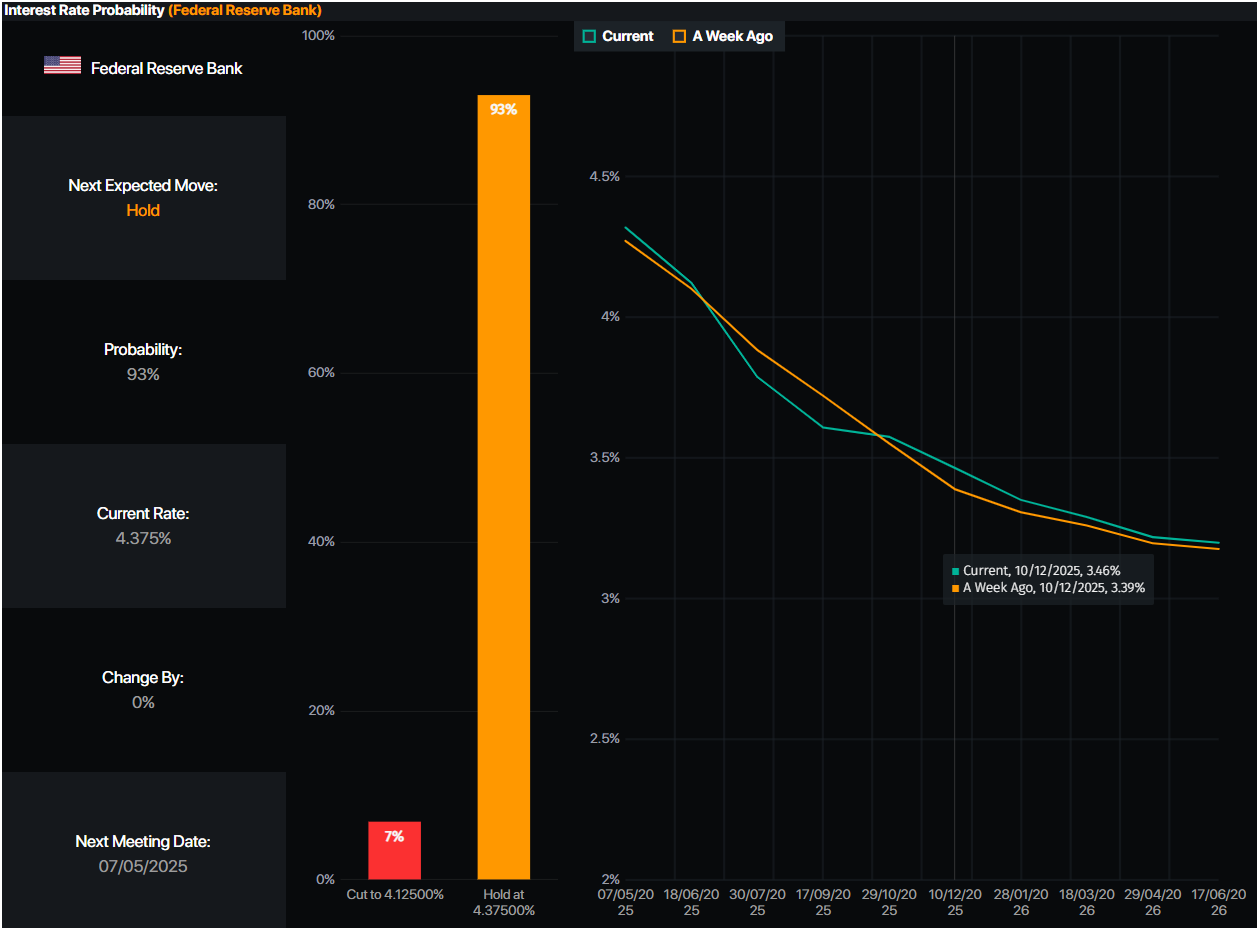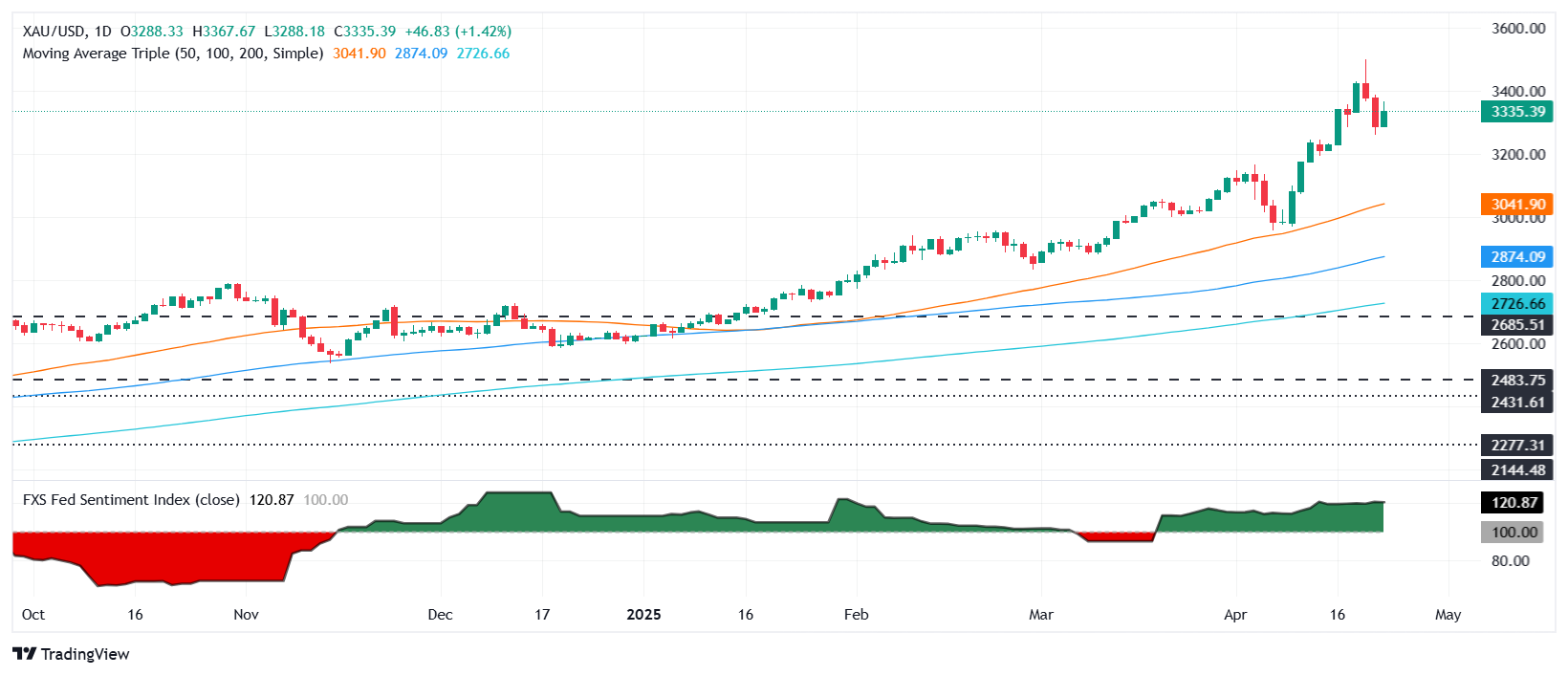Gold price surges past $3,300 on trade jitters, yield slump reviving haven demand
- Gold snaps two-day losing streak, gaining 1.5% on fresh trade war fears.
- Trump softens tariff talk, but China denies negotiations and demands full rollback.
- Fed rate cut bets rise as yields drop and economic uncertainty builds.
Gold price snapped two days of losses on Thursday and rose $50, or more than 1.50%, amid renewed concerns about the US-China trade war. Even though US President Donald Trump softened his stance on sticking to 145% tariffs on Beijing, the XAU/USD trades at $3,338 after jumping off daily lows of $3,287.
Market mood remains upbeat with Wall Street posting gains. Although traders seem relieved by Trump’s willingness to reach a deal with Beijing, China plays hardball and asks to cancel all “unilateral” US tariffs, clarifying that they have not held talks with the US government.
Bullion prices advance underpinned by the plunge in US Treasury bond yields. The US Dollar Index (DXY) is also feeling the pain after hitting four-day peaks against a basket of six currencies.
US economic data witnessed the release of Initial Jobless Claims for the last week, which was aligned with estimates. Durable Goods Orders jumped sharply in March, sponsored by airplane orders.
Meanwhile, a wave of Federal Reserve (Fed) officials grabbed the headlines. Cleveland Fed President Beth Hammack stated the Fed could act as soon as June if the data supports it but emphasized that uncertainty is weighing on business planning.
Fed Governor Christopher Waller echoed a similar tone, noting that while action in June remains on the table, rate cuts may be driven by a weakening labor market. Waller said, “rate cuts could come from rising unemployment.”
Regarding the chances of the Fed reducing interest rates at the upcoming meeting, traders see a 94% chance of keeping them unchanged, according to Prime Market Terminal. Nevertheless, traders expect the Fed funds rate to end at 3.45%, equal to 86 basis points of easing (bps).

Source: Prime Market Terminal
Daily digest market movers: Gold price climbs boosted by weak US Dollar
- The yield on the US 10-year Treasury note has decreased by seven-and-a-half basis points, reaching 4.31%.
- US real yields collapsed seven bps to 2.023%, as shown by the US 10-year Treasury Inflation-Protected Securities yields.
- US Durable Goods Orders soared in March from 0.9% to 9.2%, sponsored by aircraft bookings. Initial Jobless Claims for the week ending April 19 rose by 222K as expected, up from 216K in the previous reading.
XAU/USD technical outlook: Gold price uptrend resumes as buyers reclaim $3,300
The Gold price uptrend resumed, yet buyers must clear the April 22 high of $3,386 to prevent sellers from dragging lower prices. The next key resistance level would be $3,400, followed by the $3,450 and the $3,500 figure.
On the other hand, if XAU/USD tumbles below $3,300, this could open the door to test $3,200 ahead of the April 3 peak of $3,167. A breach of the latter will expose the 50-day Simple Moving Average (SMA) at $3,041.

Gold FAQs
Gold has played a key role in human’s history as it has been widely used as a store of value and medium of exchange. Currently, apart from its shine and usage for jewelry, the precious metal is widely seen as a safe-haven asset, meaning that it is considered a good investment during turbulent times. Gold is also widely seen as a hedge against inflation and against depreciating currencies as it doesn’t rely on any specific issuer or government.
Central banks are the biggest Gold holders. In their aim to support their currencies in turbulent times, central banks tend to diversify their reserves and buy Gold to improve the perceived strength of the economy and the currency. High Gold reserves can be a source of trust for a country’s solvency. Central banks added 1,136 tonnes of Gold worth around $70 billion to their reserves in 2022, according to data from the World Gold Council. This is the highest yearly purchase since records began. Central banks from emerging economies such as China, India and Turkey are quickly increasing their Gold reserves.
Gold has an inverse correlation with the US Dollar and US Treasuries, which are both major reserve and safe-haven assets. When the Dollar depreciates, Gold tends to rise, enabling investors and central banks to diversify their assets in turbulent times. Gold is also inversely correlated with risk assets. A rally in the stock market tends to weaken Gold price, while sell-offs in riskier markets tend to favor the precious metal.
The price can move due to a wide range of factors. Geopolitical instability or fears of a deep recession can quickly make Gold price escalate due to its safe-haven status. As a yield-less asset, Gold tends to rise with lower interest rates, while higher cost of money usually weighs down on the yellow metal. Still, most moves depend on how the US Dollar (USD) behaves as the asset is priced in dollars (XAU/USD). A strong Dollar tends to keep the price of Gold controlled, whereas a weaker Dollar is likely to push Gold prices up.

